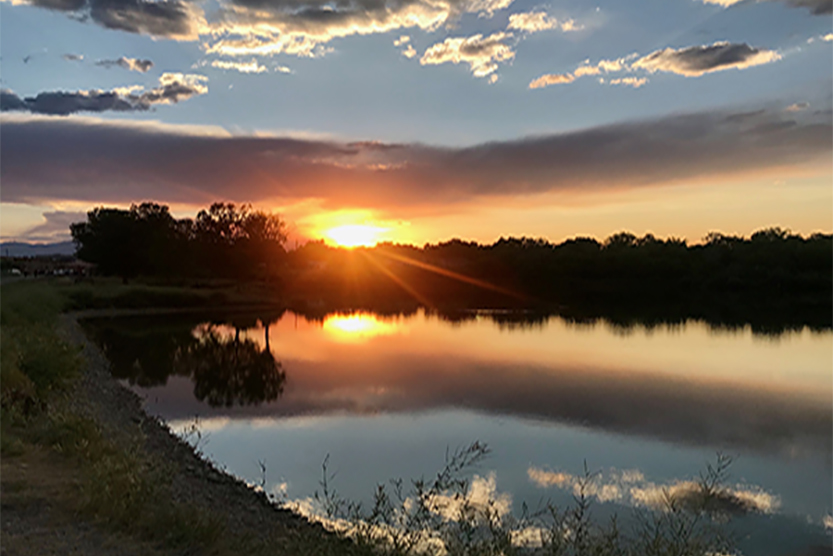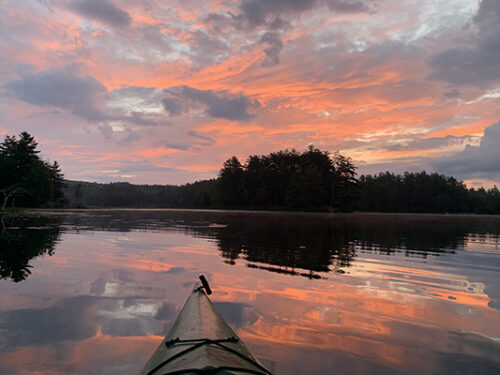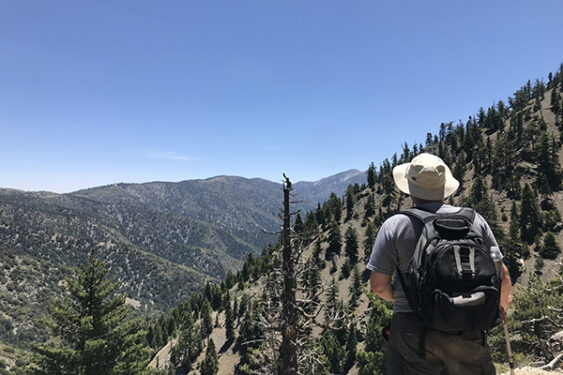
MANHATTAN — Sometimes, carrying a lot of weight on your shoulders and feeling small can be a really big thing. Anyone who hikes, camps, or backpacks knows that feeling.
You’ve climbed nearly four thousand feet, with all the gear you could possibly need strapped to your own body like an extension of you. Your legs ache, moving rhythmically for the last few miles not because you’ve wanted them to, but because they’ve been on autopilot. But after crunching countless leaves beneath your feet and snapping twigs along the way, you’re finally at the top of an immovable mountain.
The midday summer sun is shining through the clouds, casting shadows upon the peaks. A bead of sweat makes it down your hairline and along your cheek. It feels like a teardrop, maybe because it is one.
You turn around to survey the view and you’re speechless. The world is much bigger than you’re used to seeing, and you’re especially aware of your own little place in it.
For pros and novices alike, forays into nature can be a moment of physical and spiritual shifts. In these times, people of faith are finding new, non-traditional ways to connect with their bodies, God, and nature at a time when — considering the socially distanced circumstances — the closest spiritual pilgrimage might be your local nature reserve.
“This whole quarantine thing made me realize that going outside will heal you,” 25-year-old Bridgette Quiambao a St. John’s University graduate living in California told The Tablet.
“You’re in a really dark place and it‘s totally devastating. Then you just feel like everything’s a mess,” she said. “But then going outside, it reminded me that this is a world that God created, and the world is still a really beautiful place.”

Quiambao recently returned to her habit of weekly hikes, waking up as early as 3 a.m. for strenuous treks that can last as many as seven hours. “I hate waking up early, but then the moment I’m there, I’m so glad I did,” she explained. “You don’t always feel like it, but you have to open your heart to see the good in the world.”
While lockdown has taken a toll on bodies, minds, and spirits, communing in nature has been a personal blessing for Quiambao. A parishioner of St. Lorenzo Walnut, Ca., her hometown, the pandemic has prompted her to take to the peaks to reflect on the health of her body and the health of her faith, “all the time.”
She goes to the beach three times a week, has walked through the desert, and even hiked among the Blessed Virgin statues of Joshua Tree National Park.
“I just feel a lot of gratitude when I’m outside, to God, for my life, for everything. There’s a lot to be grateful for,” Quiambao explained. “If you do that, you can start to heal, and God will help you because God won’t let you go through anything that you can’t handle.”
Anyone else who has ever “Let Go and Let God,” knows the sublime in a similarly special way. Catholic writer, and hiker, Mary DeTurris Poust has dedicated hundreds of pages — and trail miles — to this idea.
“We think of St. Francis as St. Francis of Assisi, with his love of animals and his Canticle of the Sun,” she told the Tablet from her home in upstate New York. “So often, all throughout Scripture, we can find those connections to nature and to God’s creation that remind us of that beautiful place to go and just be with God.”
Poust’s book, “Everyday Divine,” focuses on how to weave prayer into everyday activities.

“I talked a lot about weaving prayer into gardening or hiking or walking or yoga or cooking, all those things that we do on a daily basis that have its own rhythm to it that lends itself to being spiritual,” she said.
“Our world tells us we have to be doing stuff…try to do things with attention and intention so that you’re focusing on what you’re doing,” added Poust, who habitually hikes in the Adirondacks with family and friends. “And I think when we slow down and be willing to go into that quiet space, it naturally opens up the doorway to a spiritual connection.”
Fellow hiker-turned-author, Kenneth Strange has written a book, “It’s Your Camino,” inspired by perhaps the world’s most well-known Catholic hike: the 500-mile Camino de Santiago in Spain.
While his future international endeavors have been put on hold due to the coronavirus, he too has turned to his own backyard to find comfort in Christ and nature anew.
“We’ve had to adapt all physically and spiritually to this situation,” Strange, 64, told The Tablet from his California home. Instead of praying indoors, his home parish holds Mass in the parking lot, and the Spanish hillsides have been traded out for local climbs and hikes.
“Especially hiking, the superficiality of your life vanishes for the most part,” Strange explained. “The noise vanishes, it’s gone. And even a hike through some beautiful landscape is inspirational. It evokes the Lord because he created all of these wonderful things around us.”
That is something Strange can’t help but think about as he stays close to home.
“Now that we’ve done the Camino, there’s always the Camino in your mind. You compare everything to the Camino,” he explained. “It is kind of like a placeholder for us. We’re not going to be walking 500 miles at a time. We’re not even going to be walking 10, 12, 15 miles a day as we did in the Camino.”
There are many ways that you can still encounter God and deepen your faith even while churches are closed, paths the saints once walked are taped off, and you are not yet able to join hands in the Lord’s Prayer.

You can jog two miles through your neighborhood, go to a body of water, or even climb a hill. Alone or with friends, your strong body and the world around it are all the signs you need to know that God is there.
“The creatures that we see, the birds, the woodpeckers, the coyotes,” Strange reminds us, “you can marvel at the creation and just say, ‘You know, He is great.’”
“Every time we lace up our shoes, every time we get to that trailhead, we know it’s going to be a reflective, spiritual experience,” he added.
So, the next time you feel lost, a bit down, or like you need a chance to connect with something bigger, take advantage of the late summer weather and double-knot your laces.

What an inspiring read in this trying time! Thanks, Wandy!